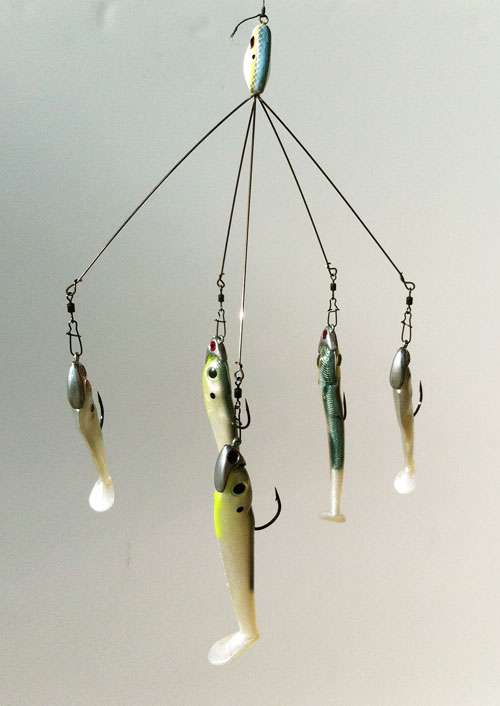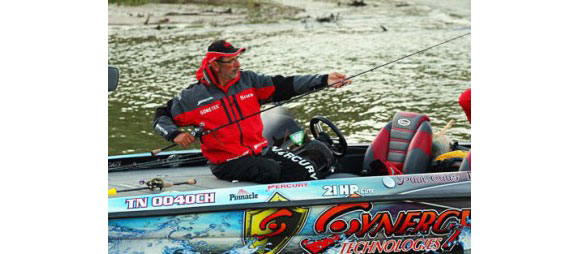
“Man, this thing’s gonna work!”
That’s what Bassmaster Elite Series pro and 1982 Bassmaster Classic champion Paul Elias said to himself when he first rigged a few soft plastic swimbaits to an “Alabama rig” and pulled them through the pond behind his Mississippi home.
He was right, too. The Alabama rig worked for Elias on Lake Guntersville to the tune of a $100,000 FLW Tour Open victory in which he lapped the rest of the field, cracking the 100-pound mark with 20 bass and besting second place by more than 17 pounds.
Elias is no stranger to introducing new techniques. In 1982, he won the Bassmaster Classic by “kneeling and reeling” (immersing most of his fishing rod beneath the water to get extra depth out of his crankbaits).
Twenty-nine years later, he’s doing it again.
If you’ve ever trolled for striped bass or other pelagic species, you probably know all about the “umbrella rig.” It’s essentially a wire harness sporting multiple “arms” to which lures or baits are attached. At its center is a line-tie (in the case of the Alabama rig, a hard bait body) and multiple arms emanate from it, almost like the spokes on a wheel. Because they’re wire, you can bend and adjust them to suit your desired presentation. Think of a mobile for a baby crib — with hooks! — and you’ll get the idea.
Elias first met the Alabama rig, and its developer, Andy Poss, at a Pickwick Lake charity tournament a few months back. Poss introduced himself and showed Elias the rig outfitted with some curled-tailed grubs. He talked about his tournament success with the device and gave Elias a couple of them. That’s when he took them home and tried them in his pond.
“I thought it was going to be great at Guntersville,” Elias said. I was going to run up to Nickajack Dam and give it a try in practice, but then the tournament officials put Tennessee waters off limits [see more about umbrella rigs and Tennessee waters below], so I almost forgot about it.”
Instead, Elias went about his practice period throwing the usual baits that appeal to Guntersville bass — frogs and rats, jerkbaits, spinnerbaits, crankbaits and dropshots — and was catching a few fish, but not exactly tearing them up.
“I was changing locations and had to go under a bridge and thought, ‘If that thing’s going to work, it ought to work here’,” and he gave it a try. But before he did, he tried all those other baits.
“And I never had a bite,” Elias said.

Paul Elias used the new Alabama rig to win $100,000 last week.
But with the Alabama rig, he had a solid limit in 16 minutes. Then he repeated his experiment: Find a bridge, try the usual baits to no avail and then whack ’em on the Alabama rig.
“I just ran the causeways,” Elias explained, “looking for suspended fish on my depthfinder and casting to them with the Alabama rig. If I could see a school on the sonar, I could catch them with this rig. It’s absolutely deadly on suspended fish — the kind of fish that have always given me and most other anglers fits.”
And it’s as a suspended bass presentation that the Alabama rig probably has its greatest application and brightest future. By counting his rig down to the productive depth and varying his retrieve through the strike zone, Elias caught 40-50 or more bass a day while other competitors struggled.
“I’d slow roll it some and burn it some, but most of my strikes came on a steady retrieve. I tried to give them some different looks.”
Rigged with five Mann’s HardNose Swimshads, Elias’ Alabama rig resembled a small school of shad. Each swimbait was impaled on a 3/8- or 1/2-ounce jighead, so the entire rig weighed 2 ounces or more. He cast it on a 7-foot, 11-inch Pinnacle flipping rod and Pinnacle reel spooled with 65-pound SpiderWire Ultracast FluoroBraid. The rod’s parabolic bend was critical to his success.
“I needed a stout rod to cast such a heavy rig,” he explained, “but it needed to be soft enough that fish wouldn’t tear off — especially when you’ve got two on at a time.”
Elias “doubled” (two bass on the rig simultaneously) several times during the tournament, but despite fishing five baits at once, he never had more than two bass on the line at once.
According to Poss’ website for the Alabama rig, it weighs less than 3/8 ounce without hooks. The rig does not use leaders — you attach your baits to a heavy-duty snap — and it’s designed to handle a wide variety of lure types, from jigs to spinnerbaits to grubs, etc. As with any umbrella rig, if the lures are rigged correctly they will not tangle.
That such a rig would work was never in doubt. Guides on Georgia’s Lake Lanier have long talked about the big spotted bass they often catch while trolling for stripers with heavy umbrella rigs using big bucktail jigs for bait. Five- and 6-pound spots frequently slam the jigs as they cross over points or submerged treetops.
The Alabama rig may revolutionize the way we fish for suspended bass. There are some caveats, though.
Don’t try it in Tennessee! The umbrella rig (and an Alabama rig is definitely an umbrella rig) is illegal there. Elias was lucky he didn’t try it below Nickajack Dam as he originally planned. He could have been ticketed.
Tennessee defines an umbrella rig as “an array of more than 3 artificial lures or baits (with or without hooks) used by a single rod and reel combination.” If you’re fishing in the Volunteer State using an umbrella rig — for any species — and your hook size is “6 or larger, then only one lure or bait may have a hook and that hook must be a single hook” (http://www.tn.gov/twra/pdfs/fishguide.pdf, p. 39).
So check your state’s regulations before giving the Alabama rig a try. You might want to hurry, though. The current backlog is five weeks!
Originally published October 2011.





